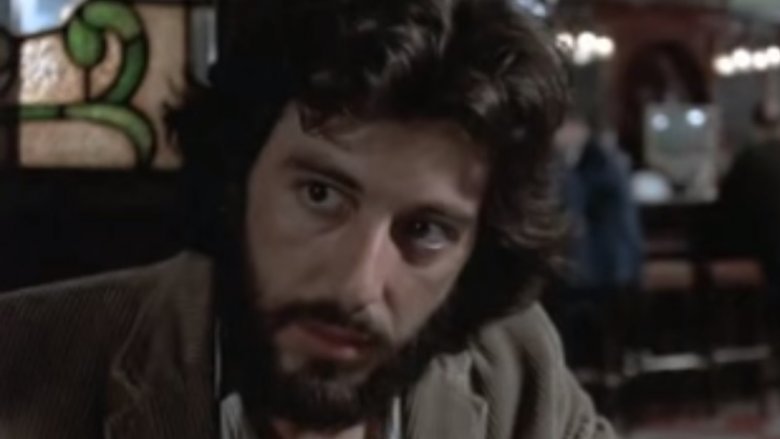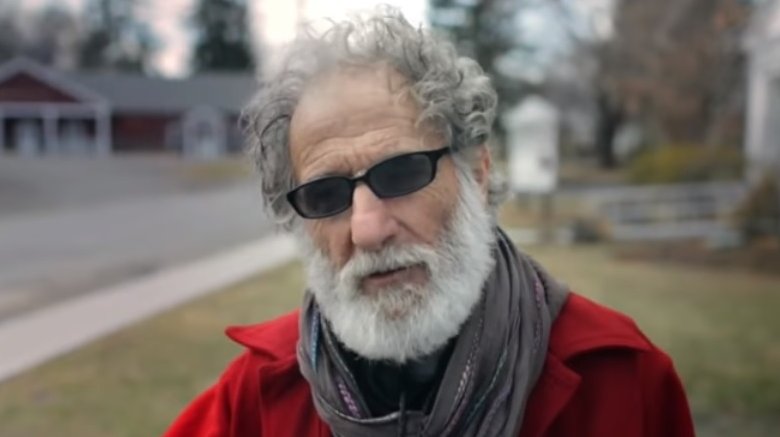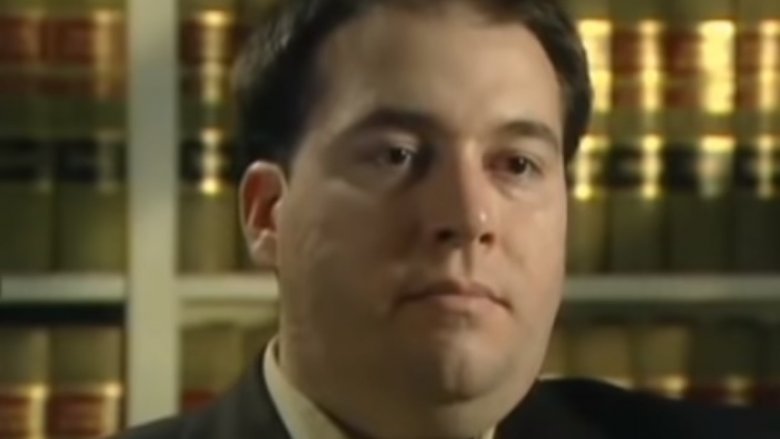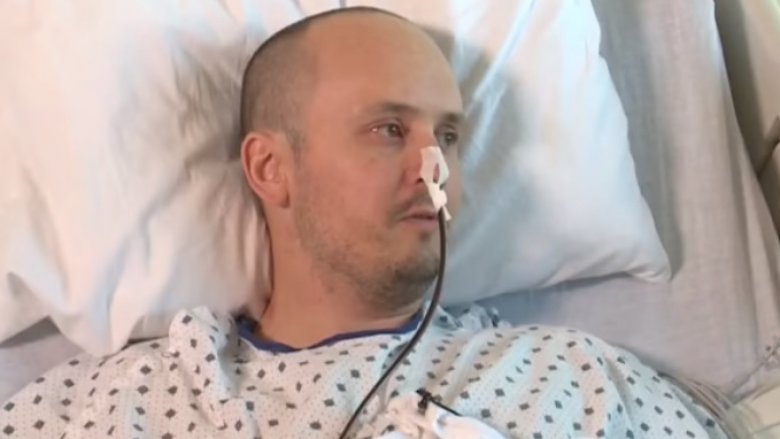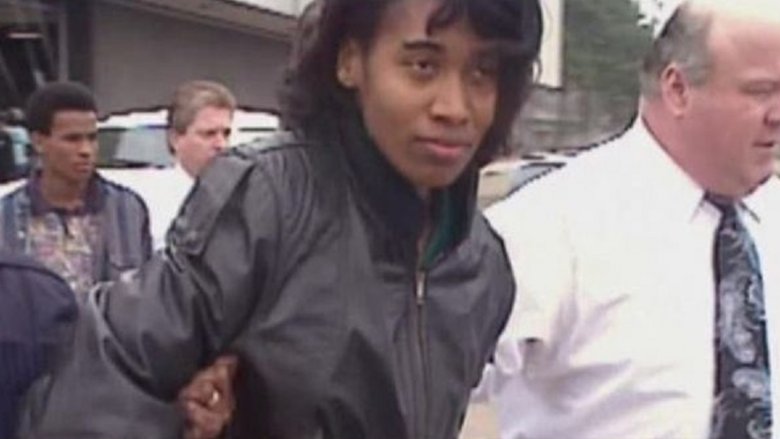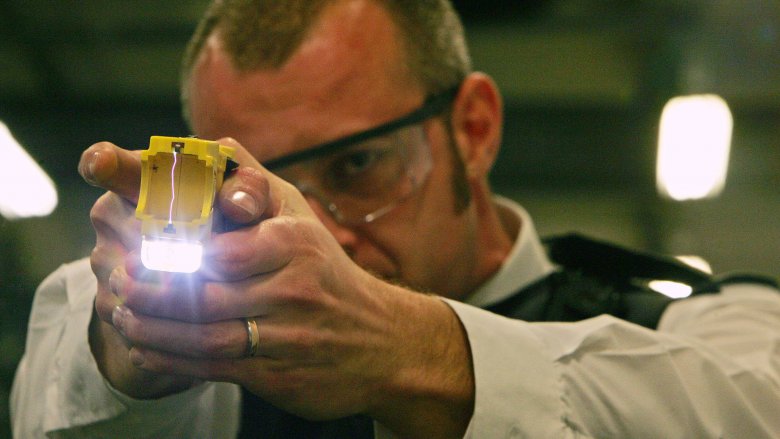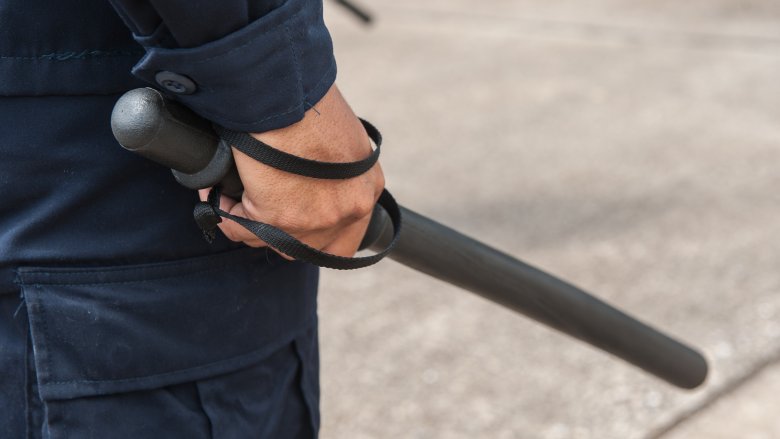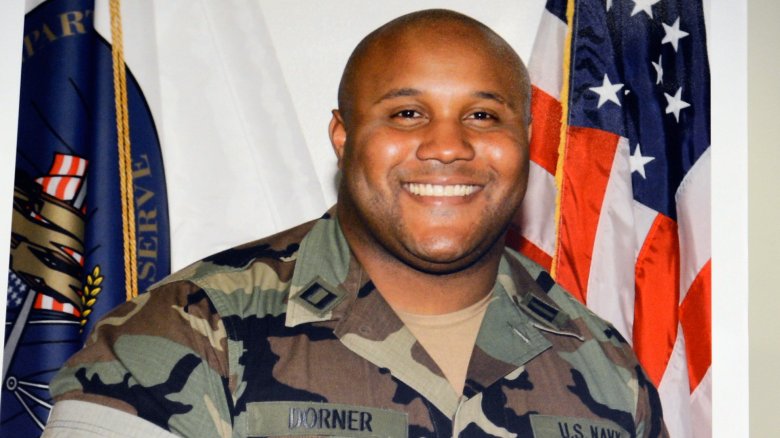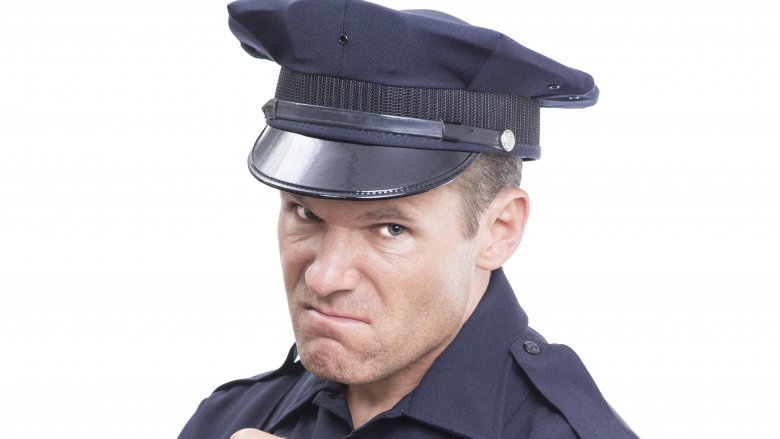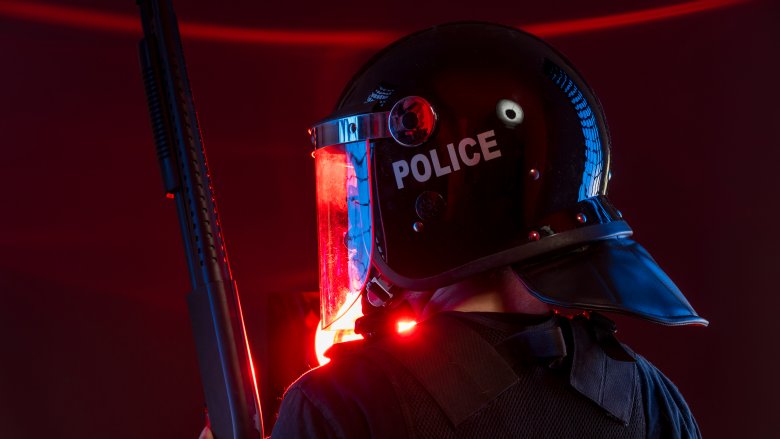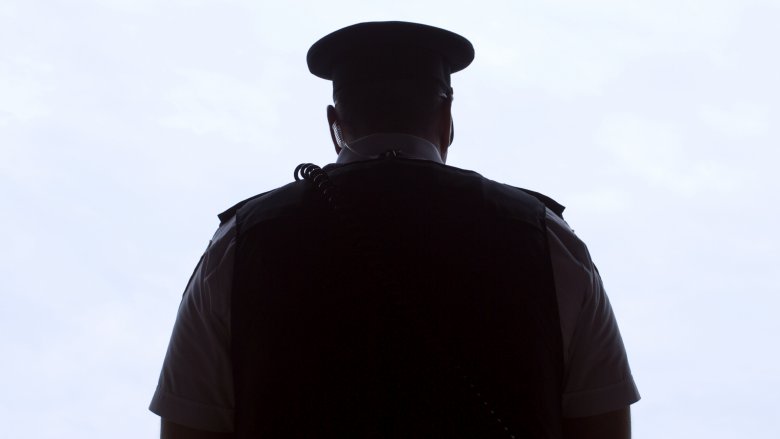Disturbing Cases Of Cop-On-Cop Crime
The world has lots of good cops who bravely risk their lives to make us safer and maintain order. But just like any group of people, police have their share of bad apples, and some departments have a bunch of them. Part of the problem is that their line of work sometimes attracts vicious criminals. Clinical psychologist Stanton Stamenow spoke with loads of "hardcore criminals" in the 1970s and found that many of them wanted to be cops as kids. Not because they wanted to uphold justice, but because they wanted "power and control for the sake of power and control."
Unfortunately, sometimes the bad guys get badges. Not only does that gravely endanger the public, but it can also place police in harm's way. Cops who try to hold lawless officers accountable can be met with terrifying reprisals. And sometimes the inner criminal of a bad cop goes into overdrive, jeopardizing the lives of other cops. Here are some of the most disturbing cases of cop-on-cop crime.
Serpico's sacrifice
Al Pacino is known for screaming and playing angry gangsters. But in 1973 he greeted the silver screen as Frank Serpico, the noble New York officer who shined a light on widespread police corruption. When Serpico became a cop the NYPD was the dark side of the police force. He first noticed something was amiss when officers burglarized a garage near his girlfriend's home. He chose to blow the lid off the problem when officers handed him $300 of ill-gotten profits, per the New York Daily News.
Serpico contacted higher-ups for months but was warned he would be "found floating dead in the East River if he persisted." He persisted and helped form the Knapp Commission, which found among other things that New York cops had gotten so crooked that tow-truck drivers could bribe them for permission to haul away wrecked cars. Failure to pay off cops could result in bogus citations and undeserved court summonses.
Serpico paid dearly for his honesty during a 1971 drug bust. His partners callously watched as a suspect pinned him in a doorway and shot him in the face. They didn't even call 911. (A concerned citizen did.) As Serpico lay in the hospital the NYPD "harassed [him] with hourly bed checks." While traveling he got targeted for strip searches. Serpico moved to Switzerland but the FBI hassled him. More than 40 years later he continued to get hate mail from police.
One sued over the cuckoo's nest
The idea of a police force fudging reports and systematically disregarding crimes might sound like the kind of unbaked conspiracy theory that tin foil hats were made for. But incriminating recordings might make that theory sound convincing. Officer turned whistleblower Adrian Schoolcraft (above) had those recordings.
Schoolcraft secretly amassed hundreds of hours of audio evidence exposing an NYPD scheme to improve the department's performance numbers by downgrading and erasing reported crimes. He shared his evidence with the Village Voice in 2010. In one recording a cop tells Schoolcraft "if it's a robbery, they'll make it a petty larceny" and then claims an incident in which someone got "punched in the face, menaced with a gun, and his wallet was removed" was labeled as a case of "lost property."
The NYPD, which later confirmed Schoolcraft's claims, initially tried to portray him as a yammering madman. A deputy chief had him forcibly admitted to a psychiatric ward. Luckily, Schoolcraft recorded that, too. After leaving work because he felt unwell, he was seized by cops who accessed his apartment by falsely telling the landlord he was suicidal. He was held at Jamaica Hospital, which charged him $7,000 for an involuntary six-day stay. Schoolcraft fought the law and won $600,000 in court. The hospital forked over another $350,000. Then Schoolcraft got sued by his own lawyers for millions in attorney's fees.
Shoot first and keeping shooting later
Albuquerque Police Lieutenant Greg Brachle was no stranger to undercover operations. And as the Daily Beast pointed out, he was also no stranger to the undercover cop he shot nine times in 2015. He and Detective Jacob Grant (above) had previously worked together for nearly two years, and Brachle knew Grant was recently involved in a sting. But even if we assume Brachle had situational face blindness there were all sorts of other clues to tip him off. Grant was dressed specifically to hint at his law enforcement status and positioned in a car where undercover cops are trained to sit during stings.
Brachle somehow overlooked all these cues, his own memory, and basic regard for human life. Instead he interrupted a sting involving a measly $60 worth of drugs, opened the car door, and started shooting without saying a word. "I remember looking at my right hand and seeing that it was blown apart," Grant recounted, "how my left arm felt like it was hanging off, like it was obliterated." He also remembered saying, "Please stop shooting me," as he crawled across the ground. Grant lost 80 percent of the blood in his body. Brachle's itchy trigger finger had landed him in hot water before. In 2000 he was unsuccessfully sued for shooting a dude who had his hands up. Grant fared better in court and received a $6.5 million settlement.
Cop, robber, killer
You would have to be crazy to hire a mentally unstable person with a history of dishonesty to do a job that allows them to boss people around at gunpoint. Or you would have to be the New Orleans Police Department during the 1990s. According to People, between October 1994 and October 1995 a whopping 31 New Orleans officers were arrested for offenses such as rape, homicide, and drug trafficking. Included in that crooked police lineup was Antoinette Frank.
When Frank applied for a job at the NOPD in 1991, she wasn't fit to hold a squirt gun. She failed the department's psychological tests on integrity, empathy, and impulse control and blatantly lied on her application. Rejecting her should have been a slam dunk, but the NOPD was short on cops. Frank showed them a doctor's note that said she wasn't as unstable as her tests indicated, and her enormous shortcomings were eventually overlooked.
Tragically and unsurprisingly, Frank ran afoul of the law. She befriended 19-year-old drug dealer Rogers Lacaze and kept him out of prison. After possibly robbing other dealers together, they then decided to rob a restaurant where Frank moonlighted as a security guard. In the process Frank fatally shot her former patrol partner, Ronald Williams, in the head and killed two restaurant employees. She was sentenced to death in 1995 but is still on death row in Louisiana.
The road to hell is paved with good policing
When duty calls, cops can legally burn more rubber than a tire store fire. But Officer Fausto Lopez was off-duty and running late for a second job when he decided to drive 120 mph down a Florida highway in his police cruiser. Highway Patrol Officer Donna Watts refused to let Lopez drive like a lunatic so she pulled him over and drew her gun.
According to the Miami Times, a cop caught breaking the law in public would normally receive a "professional courtesy," which is a euphemism for "free pass." But as the Sun-Sentinel described, Watts publicly cuffed Lopez and cited him for driving recklessly. He was ultimately fired. That principled decision inspired a Pulitzer Prize-winning investigation that showed Florida cops speed illegally all the time.
Watts got a lot of crap for her principled decision. Human poop was smeared on her car, and pizzas were sent to her house. She received death threats and harassing hang-up phone calls. Police cars followed her and waited near her home. A terrified Watts did some digging and discovered that 88 officers from 25 jurisdictions had illegally looked up her personal info more than 200 times. She sued, and multiple localities coughed up tens of thousands of dollars. However, a few defendants won in court by claiming they looked her up because they feared for their safety after she pulled over an officer at gunpoint.
A use of stunning force
In 2007, Boynton Beach Police Officer David Coffey lost his job for going berserk on a drunk driver and treating a Taser like a toy. As detailed by the Sun-Sentinel, Coffey was caught on film "grabbing the driver by the throat, pushing him against a metal bench and forcing his head against a concrete wall." When the man was handcuffed and helpless, Coffey stunned him four times with a Taser, according to the Palm Beach Post. Somehow, instead of getting arrested he got his job back in 2008 with the help of an arbitrator.
Having learned a valuable lesson about the consequences of misconduct, Coffey misused his Taser again after getting rehired. Only, this time he actually got in legal trouble because his victim was another cop. Officer Rachel Loy had committed the sin of honking her horn in a parking garage and startling Coffey. He held that irrational grudge for a month before retaliating in 2011. While Loy was sitting at her computer at the station, Coffey fired his Taser while holding it right behind her ear. Seriously, who does that? Oh wait, probably someone who beats handcuffed prisoners.
Loy suffered hearing loss, and a Taser expert noted that her hair could have also caught fire. Coffey, however, caught hell. He was fired (naturally), convicted of improperly displaying a dangerous weapon, and given a slap on the wrist: one of year of probation.
Come quietly and there will still be trouble
A common mantra in police brutality cases is that suspected criminals ought to cooperate if they don't want to get punched by the long arm of the law. But suspects are sometimes punched even if they do cooperate. Officer Larry Jackson of the NYPD experienced that when his wife called the cops to stop an armed intruder who crashed his daughter's 21st birthday party. Jackson not only cooperated; he explained that he was also a cop. Nevertheless, as many as a dozen cops beat him with batons, pepper-sprayed him, and choked him within an inch of his life.
It's not clear why Jackson's brothers in blue assumed he was the intruder rather than the homeowner, but the New York Daily News noted that he was 6-foot-3, 300 pounds, and black. Not that those things would have biased the police against him or anything. Maybe it was just a miscommunication, which may explain why officers repeatedly told Jackson to "relax" as he tried to explain he was suffocating. The police beat him so badly that he permanently lost strength in one of his hands.
Jackson sued, and a jury awarded him $15 million. The NYPD considered his award "too excessive," sort of like the amount of force police used. A judge recommended lowering the amount to $5.4 million. Jackson's attackers weren't punished because the law safeguards against judging officers' mistakes too harshly. Beating suspects needlessly on the other hand...
Injustice is blind rage
On paper Christopher Dorner (above) sounded like the stuff role models are made of. A one-time cop, Navy reservist, and award-winning marksman with several military accolades, Dorner lived near Disneyland and liked to pump iron outside his "tasteful bungalow," per the BBC. But behind his smile was a joyless killer driven by retribution.
The root of Dorner's rage was his 2008 firing from the Los Angeles Police Department. He had previously accused a fellow officer of kicking a mentally ill suspect, but in the absence of definitive proof Dorner was branded a liar and fired. A man with simmering resentment over years of perceived mistreatment, he took the incident as evidence of police corruption and societal racism he had endured since childhood. He spiraled into a rage-fueled obsession that culminated in a murder spree targeting the LAPD in 2013.
His extensive combat and counterterrorism training made him a formidable killer. He murdered the daughter of a former police captain and her fiancé, ambushed and killed a patrolman, and allegedly killed two other officers in ambushes. A frantic manhunt for Dorner produced more casualties as anxious LAPD officers shot one man and two women after somewhat inexplicably mistaking them for Dorner. A nine-day search ended with a standoff and Dorner dying in a burning cabin.
Undercover and over-the-top
Undercover cops in Detroit adhere to a select set of procedures to prevent friendly fire between members of different precincts. The protocols stem from a 1986 mix-up that ended in two Detroit cops being fatally shot. Knowing the gravity of these procedures, you might think that after three decades of implementing them Motor City's Finest would avoid friendly fisticuffs. And you'd be right, but only because when they punched each other it wasn't remotely friendly.
As detailed by the Detroit Free Press, in 2017 undercover officers from the 11th and 12th precincts unwittingly entered the same neighborhood in hopes of making a drug bust. Two cops from the 11th spotted officers from the neighboring precinct and, assuming they were bad guys, ordered them to the ground. Then the remaining officers from the 11th started raiding a suspected drug house when more officers of the 12th showed up looking to do some drug-busting of their own.
Things got heated when the two factions disagreed over who had the right to search the house. Soon some of the two dozen officers present were punching, shoving, and head-locking each other. Detroit's police chief called it "probably one of the most embarrassing things I've seen in this department." The fact that it was only probably and not definitely "one of the most embarrassing things" he'd seen is probably the most embarrassing thing about it.
Snitches get dead rats
Detective Joseph Crystal grew up on a steady diet of law and order. Both his folks were New York cops, and he felt duty-bound to serve the public. Long before joining the force he enlisted in the Coast Guard and stood watch over the remains of the World Trade Center after 9/11. He described being a cop as "a dream come true." So imagine Crystal's chagrin when he realized some of his coworkers were crooks whose badges doubled as get-out-of-jail-free cards.
His dream job started to turn sour in October 2011. That was when he saw officers drag a drug suspect behind a house and, after audible sounds of violence, brought him back out with a torn shirt and a freshly fractured ankle. Conflicted on how to respond, Crystal called his parents, who warned, "Once you lose your integrity, it's gone." So he called his sergeant, who warned, "If you snitch, your career is done. Nobody's going to work with you." They were both right.
Crystal kept his integrity by exposing the officers' brutality, but he became a workplace outcast. His requests for backup were refused. Someone placed a rat corpse on his windshield for him and his wife to find. He was taken off an FBI investigation with no explanation and assigned to low-level crimes. Crystal sued and received $42,000.
The black and blue wall of silence
There's a reason fans of rival sports teams sloppily clobber each other at stadiums (two reasons if you count alcohol): Teams plus tension equals aggression. That doesn't just apply to sporting events. When things get adversarial between police and protesters, you effectively have two teams squaring off in an ad hoc arena. One side even wears a uniform. However, in theory cops would look to diffuse rather than escalate tense encounters. But four officers in St. Louis seemed eager to bash protesters' heads in.
The Riverfront Times reported that in 2018 officers Dustin Boone, Bailey Colletta, Randy Hays, and Christopher Myers were indicted for assaulting an undercover cop they mistook for a protester in 2017. Despite his compliant behavior they attacked him with armored boots and riot batons. Granted, without proper context, it's unfair to assume malicious intent. What if they were scared? Thankfully, Boone's text messages to the other officers shed light on the matter.
In a text before the protest Boone wrote, "it's gonna be a lot of fun beating the hell out of these sh**heads once the sun goes down and nobody can tell us apart!!!" Later he wrote, "It's still a blast beating people who deserve it." He even seemingly advised an officer to hide "rogue" behavior by getting "an old white dude" to be a witness. As of this writing, the resulting criminal case hasn't been decided.
Officer stalker
It doesn't take Sherlock Holmes to deduce that stalking is wrong. But for reasons discernible to no one, Scotland Yard police detective Jose Lagares decided stalking was the solution to his loneliness. It all started when Detective Svetlana Puzovic confided in Lagares, her friend for 15 years, about an ex-boyfriend who had been harassing and threatening her. Instead of being a source of moral support, Lagaras tossed all morality and support out the window.
As the Evening Standard described, Lagares went to her house uninvited at least 10 times between September 2017 and August 2018. He also haunted her bus stop and hid in a stairwell opposite her home. Somehow it gets creepier. Despite Puzovic's pleas for Lagares not to investigate her ex-boyfriend, he "asked the officer in the case to send all correspondence to him." So while Lagares was stalking his friend, he could also see the ways in which she was being threatened by another person who was close to her. Thankfully, he was fired.
